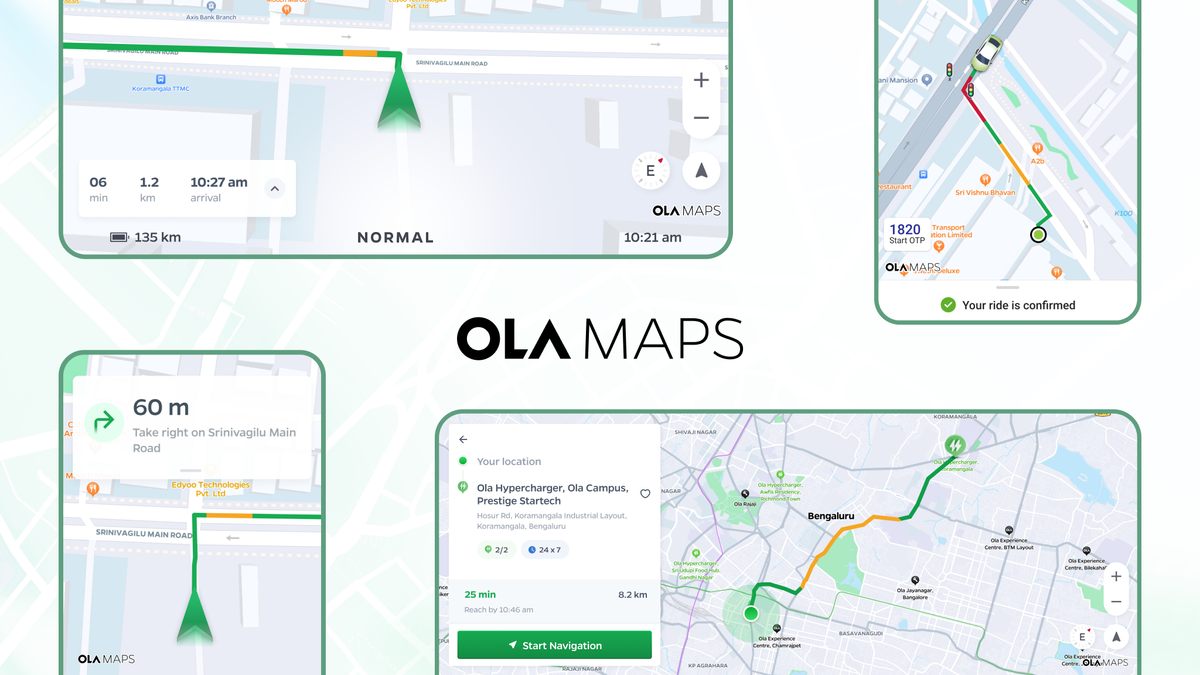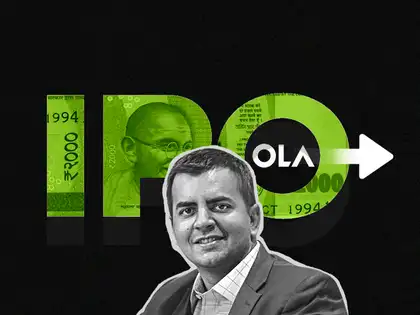Published
9 months agoon

Bhavish Aggarwal, the force behind Ola Group, is making headlines again. With talk of a second public listing, Aggarwal is now gearing up to overhaul the holding structure of his companies, starting with a revamp of Ola Maps.
What’s Changing?
In the coming months, Aggarwal plans to consolidate his various businesses into a conglomerate structure. This will bring Ola Electric (the EV giant), Ola Consumer (the rebranded ride-hailing app), and his AI venture, Krutrim, under one umbrella. Right now, these companies are considered “associate companies,” meaning they’re connected but not fully controlled by a single parent entity.
The move to a conglomerate model could bring tighter control, risk diversification, and a gateway to new markets. Aggarwal’s restructuring will also centralize leadership, streamline tech assets, and place overall management under the BA Family Office.
Why Restructure Now?
The restructuring aims to make the group more efficient and focused. By converting associate companies into subsidiaries or fully-owned entities, Aggarwal is positioning the group for stronger synergy and a unified vision. For instance, Ola Maps, which has been at the center of some legal and public spats, will now play a key role in Krutrim’s AI ambitions.
Aggarwal’s first company, Ola Cabs (now Ola Consumer), has evolved from a cab service to a broader consumer platform. Ola Electric went public last year, and Krutrim, his latest AI-focused venture, is already laying the groundwork for ambitious projects like Ola Maps.
Spotlight on Ola Maps
Ola Maps, currently housed under Krutrim, is Aggarwal’s attempt to challenge big players like Google Maps and MapMyIndia. The idea is to shift the maps business entirely from Ola Consumer (formerly Ola Cabs) to Krutrim.
Ola Maps relies heavily on data from Ola Consumer’s vast operations—30 million monthly active users and 6.5 million daily trips provide a treasure trove of location intelligence. While Krutrim uses OpenStreetMap, government data, and Ola’s own data, its roots trace back to October 2021 when Ola Consumer acquired Geospoc Geospatial Services to build advanced location tech.
Krutrim’s Bold Vision
For Bhavish Aggarwal, maps are not just a side project—they’re a cornerstone of his plans for Krutrim, his ambitious AI startup. With its focus on AI chips, large language models (LLMs), and AI-powered maps, Krutrim is gearing up to tackle big challenges. And maps, it seems, are leading the charge.

Why Maps Matter for Krutrim
Maps are central to Krutrim’s strategy, not just as a product but as a revenue driver. Leveraging rich data from Ola Cabs’ extensive operations and Ola Electric’s scooters, Krutrim has access to a steady stream of real-world navigational data. This data forms the foundation for building AI-driven maps, positioning Krutrim to compete with giants like Google Maps and homegrown players like MapMyIndia.
Aggarwal brought in heavy hitters to strengthen Krutrim’s maps division, including Prasad Kavuri, a former leader at Here Technologies—a global mapping pioneer. Under Kavuri’s leadership, Krutrim’s maps team of 40 is collecting city-level data to refine its offering.
Funding the Vision
Building AI chips and cutting-edge maps requires significant capital, and Aggarwal plans to meet these needs through his BA Family Office. Established in mid-2023, this office manages the wealth generated from Aggarwal’s 36% stake in Ola Electric, valued at ₹12,300 crore. Funds from this stake, which became liquid after Ola Electric’s IPO, are being reinvested into Krutrim’s growth.
The MapMyIndia Controversy
However, Aggarwal’s focus on maps hasn’t been without its challenges. Early in the project, Ola faced accusations of data theft from MapMyIndia, which alleged a breach of its licensing agreement dating back to 2015. While MapMyIndia’s CEO Rohan Verma publicly criticized Ola, the company quickly refuted the claims.
Despite the controversy, Aggarwal remains undeterred. He’s vocal about his vision for Ola Maps, even calling out Google Maps for its limitations. Inspired by MapMyIndia’s success—the company doubled its market cap post-IPO and boasts an EBITDA margin of over 40%—Aggarwal believes Krutrim is better positioned to tap into the growing demand for mapping technology in India.
Ola Consumer IPO
Bhavish Aggarwal’s ambitious plans for Ola Consumer’s IPO come at a time when the company is struggling with multiple challenges. While corporate restructuring and business realignment are underway, Aggarwal is also under pressure from investors eager for an exit after years of waiting.

Investors Push for the Exit Door
Ola Consumer boasts a robust roster of over 100 investors, including marquee names like Softbank, Temasek, Warburg Pincus, and Tiger Global. Many of these stakeholders have been invested for 6-10 years and are now seeking to realize their returns. Aggarwal had initially aimed for an IPO as early as 2020, but delays have left investors anxious. A broad understanding to create an exit pathway by late 2024 hasn’t materialized, making the 2025 IPO crucial for restoring confidence.
Market Headwinds and Diversification Strategies
The timing, however, is less than ideal. Ola Consumer’s flagship cab-hailing business is losing ground. Uber has solidified its lead in the car category, while Rapido has shown significant growth, pushing Ola to third place in the three-wheeler segment. These setbacks in Ola’s core mobility business illustrate the urgency to diversify and showcase new growth avenues.
One such initiative is Ola Consumer’s deepening partnership with the Open Network for Digital Commerce (ONDC). By expanding its delivery fleet on the ONDC platform, Ola is signaling its intent to leverage its brand, user base, and data to create fresh revenue streams.
The Ola Maps Problem
The restructuring plan, which includes moving Ola Maps from ANI Technologies to Krutrim, has stirred mixed reactions among investors. Some see parallels to the formation of Ola Electric in 2017, which was spun out of Ola Cabs’ in-car entertainment division. Back then, Ola Electric was carved out with Aggarwal retaining 90% ownership, leaving Ola Cabs with a mere 7.5% stake.
Now, with Ola Maps originally developed under Ola Consumer being absorbed into Krutrim, concerns about fair compensation for existing investors have resurfaced. “He could probably offer them some stake in Krutrim or compensate them in some way,” said a source. However, the details of any potential quid pro quo remain unclear.
Retail Investor Sentiment, A Trust Deficit?
Amid these developments, retail investors are watching closely, and not all feedback has been positive. Critics have drawn unflattering comparisons to high-profile failures like DHFL and Kingfisher Airlines, accusing Aggarwal of prioritizing personal gains over the interests of smaller investors.
Comments like, “You saw the golden pie and now want to grab every slice before saddling losses in Ola Electric,” reflect a growing mistrust. For Aggarwal, addressing these concerns and demonstrating a clear roadmap for growth and profitability will be essential to rebuilding confidence.
The Last Bit
As Ola Consumer prepares for its IPO, Aggarwal faces the dual challenge of satisfying investor expectations while managing a competitive market ecosystem. The success of this public offering will depend on how well Ola can pivot from setbacks to opportunities and whether it can deliver on its promise of becoming a diversified, future-ready conglomerate.
For Aggarwal—this IPO isn’t just about raising funds; it’s about reaffirming his vision for Ola and restoring faith in the company’s ability to innovate and grow sustainably. Likewise, his strategy for Krutrim is about redefining what’s possible in AI and mapping technology.
